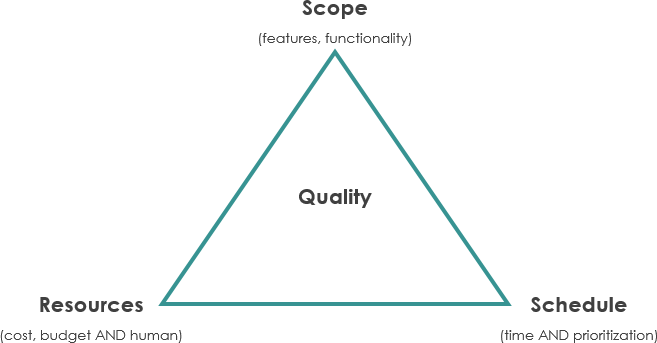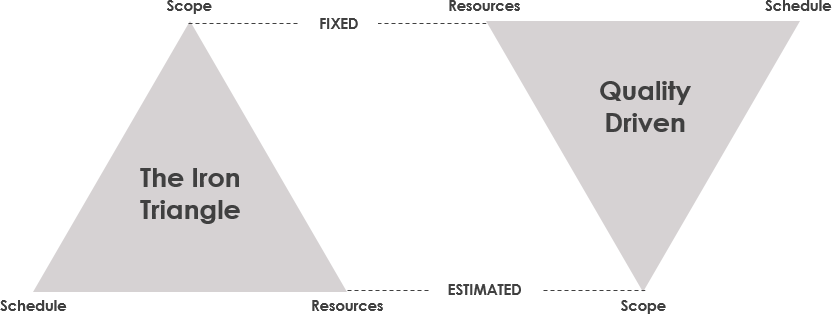The Project Management Triangle (also known as Triple Constraint, Iron Triangle and “Project Triangle”) is a model of the constraints of project management. Success in project management has been traditionally associated with the ability of the constraint parameters of projects in scope, time, cost, and quality called iron triangle. It is a popular metaphor pointing out that the project manager is asked to reach a reasonable trade-off among these constraints.
Project managers often require a balancing act between key factors that constrain the overall project delivery. As such, the quality of work is constrained by the project’s budget (funding and resources), deadlines (time) and scope (features). These three factors are the well-known attributes of scope, schedule, and cost as shown in the Figure below:

Even if the project manager is allowed to have some flexibility to trade between constraints and obviously, changes in one constraint necessitate changes in others to compensate or quality will suffer. For example, a project can be completed faster by increasing the budget or cutting scope. Similarly, the increasing scope may require equivalent increases in budget and schedule. Cutting budget without adjusting schedule or scope will lead to lower quality.
Where a customer asks for a fixed price quote before agreeing to project commencement but is flexible on what is delivered and how long it takes.
Where a customer asks for delivery by a certain date but is flexible in scope and cost.
Where a customer asks for a fixed set of deliverables but is flexible in the time it takes to deliver and the cost of delivery. This is sometimes known as “heavy agile”.
Where the customer asks for a fixed price quote for a fixed set of deliverables. In this situation, the final date for delivery is flexible. As well as the points in fixed cost and fixed scope;
Where the customer asks for a fixed price quote by a fixed time. In this situation, the exact set of features (or scope) for delivery is flexible. As well as the points in fixed cost and fixed time;
Where the customer asks for a fixed set of deliverables by a fixed time. In this situation, the total cost to the customer is flexible. As well as the points in fixed time and fixed scope;
Where the customer gives no flexibility in the project.
In the traditional approach, the triangle would typically look like the one on the left as shown in the Figure below. As you can see, there is a fixed scope of product requirements. So to ensure the product can be completed all of our required features, we need to be a little flexible with our resources (and budget), and schedule (deadlines). If we need the product to have a list of features described in the upfront requirement specification, perhaps we need to delay the release date by several months or more in reality.
In the Agile sense, there is a fixed schedule (in Scrum we do this through time-boxed Sprints and fixed resources. Thus when things don’t work according to the plan, it is the scope that needs to be reduced. In Agile, however, we ensure that even if we have to compromise on scope, we are still delivering the highest priority items in the product backlog for maximizing the value yielded by the project.
